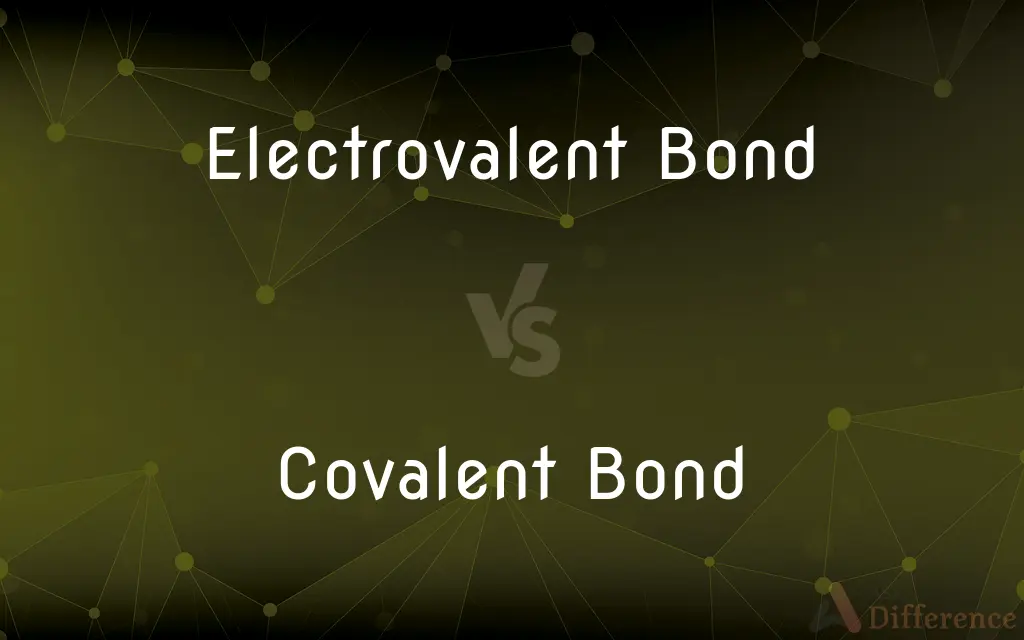Electrovalent Bond vs. Covalent Bond — What's the Difference?
By Tayyaba Rehman — Published on January 14, 2024
Electrovalent bonds involve transfer of electrons between atoms, while covalent bonds involve sharing of electrons.

Difference Between Electrovalent Bond and Covalent Bond
Table of Contents
ADVERTISEMENT
Key Differences
Electrovalent bonds, also known as ionic bonds, are formed when electrons are transferred from one atom to another, leading to the creation of oppositely charged ions that attract each other. In covalent bonds, atoms share one or more pairs of electrons to achieve stability.
In an electrovalent bond, typically a metal atom loses electrons, becoming positively charged, and a non-metal atom gains electrons, becoming negatively charged. In contrast, a covalent bond usually forms between non-metal atoms that have similar electronegativities and therefore share electrons.
Electrovalent bonds result in the formation of ionic compounds, which generally have high melting and boiling points and conduct electricity when molten or dissolved in water. Covalent bonds create molecular compounds, which often have lower melting and boiling points and do not conduct electricity.
The strength of electrovalent bonds is influenced by the charge and size of the ions; higher charges and smaller ions lead to stronger bonds. Covalent bond strength depends on the shared electron pair and the distance between the nuclei of the bonded atoms.
Electrovalent compounds are usually soluble in water and other polar solvents, while covalent compounds are often insoluble in water but soluble in nonpolar solvents like benzene or chloroform.
ADVERTISEMENT
Comparison Chart
Electron Movement
Transfer of electrons.
Sharing of electrons.
Types of Atoms Involved
Usually metal and non-metal.
Usually non-metals.
Compound Type
Forms ionic compounds.
Forms molecular compounds.
Electrical Conductivity
Conducts electricity when dissolved or molten.
Generally does not conduct electricity.
Melting/Boiling Points
High melting and boiling points.
Lower melting and boiling points.
Compare with Definitions
Electrovalent Bond
Involves transfer of electrons from one atom to another.
Sodium chloride forms through an electrovalent bond by electron transfer.
Covalent Bond
Involves sharing of electrons between atoms.
Oxygen molecules are held together by a covalent bond.
Electrovalent Bond
Another term for electrovalent bond.
Table salt is the result of an ionic bond.
Covalent Bond
Another term for covalent bond.
Water is formed by molecular bonds between hydrogen and oxygen.
Electrovalent Bond
Results in formation of oppositely charged ions.
In an electrovalent bond, sodium becomes positive and chloride becomes negative.
Covalent Bond
Typically occurs between non-metal atoms.
Methane is a result of covalent bonding between carbon and hydrogen.
Electrovalent Bond
Often occurs between metals and non-metals.
Magnesium oxide forms an electrovalent bond between magnesium and oxygen.
Covalent Bond
Shares pairs of electrons.
In a covalent bond, atoms share one or more pairs of electrons.
Electrovalent Bond
Leads to the formation of ionic compounds.
Electrovalent bonds are responsible for the structure of ionic compounds like potassium bromide.
Covalent Bond
Forms molecular compounds.
Covalent bonds are characteristic of molecular compounds like carbon dioxide.
Common Curiosities
Do Electrovalent Bonds form molecules?
No, they form ionic compounds, not molecules.
What is a Covalent Bond?
A bond where atoms share one or more pairs of electrons.
Can Covalent Bonds conduct electricity?
Generally, covalent compounds do not conduct electricity.
What types of elements form Covalent Bonds?
Covalent bonds typically form between non-metal elements.
Are Electrovalent Bonds common in organic chemistry?
No, they are more common in inorganic chemistry.
Can Electrovalent Bonds form between two non-metals?
Typically, they form between metals and non-metals.
What is an Electrovalent Bond?
A bond formed by the transfer of electrons between atoms, creating ions.
Can Covalent Bonds be broken easily?
It depends on the bond strength; some are easily broken, while others are very strong.
Are Electrovalent Bonds strong?
Yes, they are generally strong due to electrostatic attraction.
Is water an example of a Covalent Bond?
Yes, water is formed by covalent bonding between hydrogen and oxygen.
Are Electrovalent compounds soluble in water?
Yes, many ionic compounds are soluble in water.
Are all Covalent Bonds polar?
Not all; covalent bonds can be polar or nonpolar.
Do Covalent Bonds have high melting points?
No, they generally have lower melting points compared to ionic compounds.
What is the role of electronegativity in Electrovalent Bonds?
It influences the transfer of electrons; a higher difference in electronegativity favors ionic bonding.
Do Electrovalent Bonds share electrons?
No, they involve the complete transfer of electrons, not sharing.
Share Your Discovery

Previous Comparison
Resting Potential vs. Action Potential
Next Comparison
Vulcanized Rubber vs. Unvulcanized RubberAuthor Spotlight
Written by
Tayyaba RehmanTayyaba Rehman is a distinguished writer, currently serving as a primary contributor to askdifference.com. As a researcher in semantics and etymology, Tayyaba's passion for the complexity of languages and their distinctions has found a perfect home on the platform. Tayyaba delves into the intricacies of language, distinguishing between commonly confused words and phrases, thereby providing clarity for readers worldwide.
















































